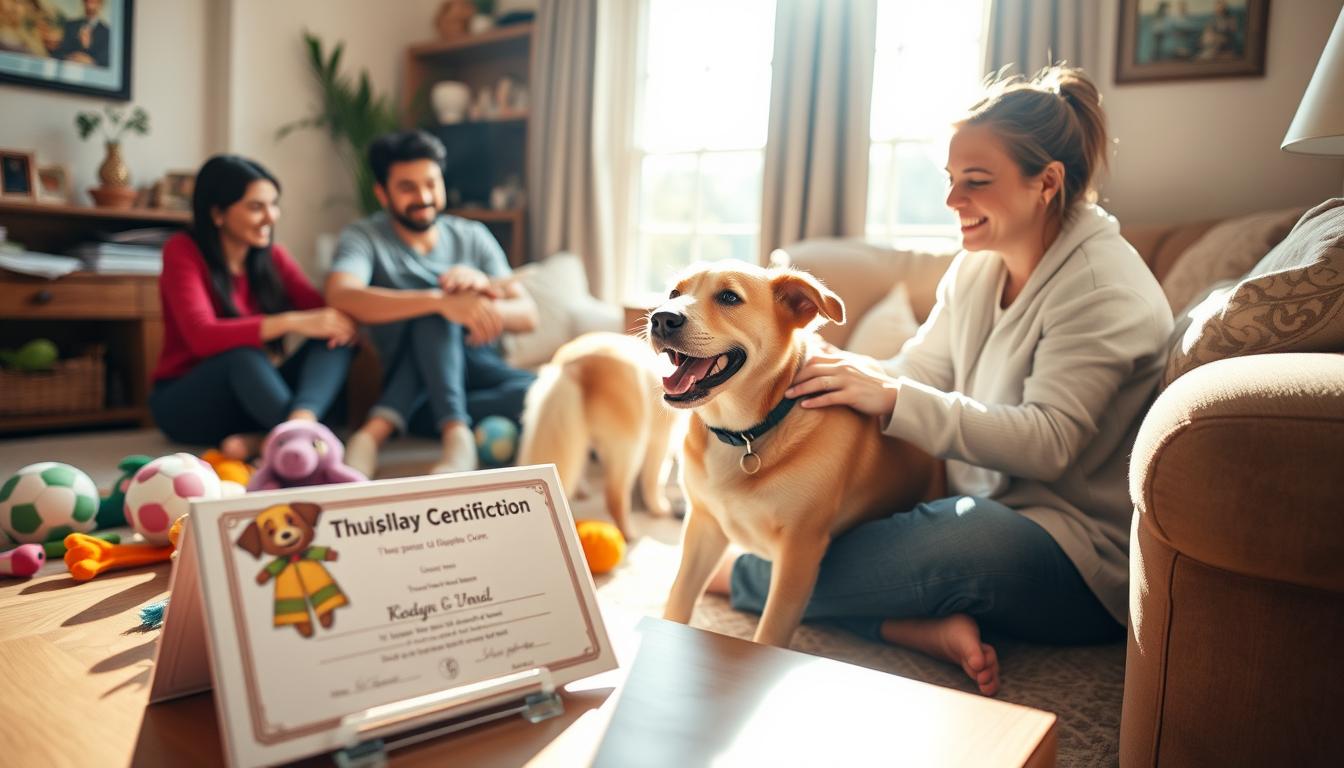Adopting dog key things to know. Discover essential things to know. Thinking of getting a dog? It’s a big decision, but it can be incredibly rewarding. Before you bring a dog home, there are important things to think about. This guide will help you understand what to consider, from your lifestyle and budget to choosing the right dog and getting your home ready.
Being well-informed and prepared is key for a happy adoption. It ensures a great experience for you and your new dog.
Key Takeaways
- Understand the responsibilities and costs involved in owning a dog before adopting.
- Research different dog breeds to find the one that best fits your lifestyle and home environment.
- Prepare your home and create a safe, comfortable space for your new pet.
- Establish a training and socialization plan to help your dog adjust to their new surroundings.
- Prioritize your dog’s health and well-being by budgeting for veterinary care and providing necessary exercise and enrichment.
Introduction
Bringing a dog into your home can fill your life with joy and love. Dog adoption is a great way to give a loving home to a shelter or rescue dog. But, it’s important to know the special needs and challenges of caring for a dog.
The Joys of Dog Ownership
Dogs bring companionship, loyalty, and endless fun. Seeing a rescue dog thrive in a new home is heartwarming. Many shelter dogs are very thankful for their new homes and bond deeply with their families.
The Responsibilities of Dog Ownership
Dog ownership requires a lot of time, effort, and money. Dogs need regular exercise, training, grooming, and vet visits. The cost of caring for a dog can range from $300 to $400 a year, with vet bills from $200 to $5,000.
Why Adopting a Shelter Dog is a Great Option
Adopting a shelter dog or rescue dog is very rewarding. These dogs have unique stories and have faced tough times. By adopting them, you not only improve your life but also give a second chance to a deserving dog.
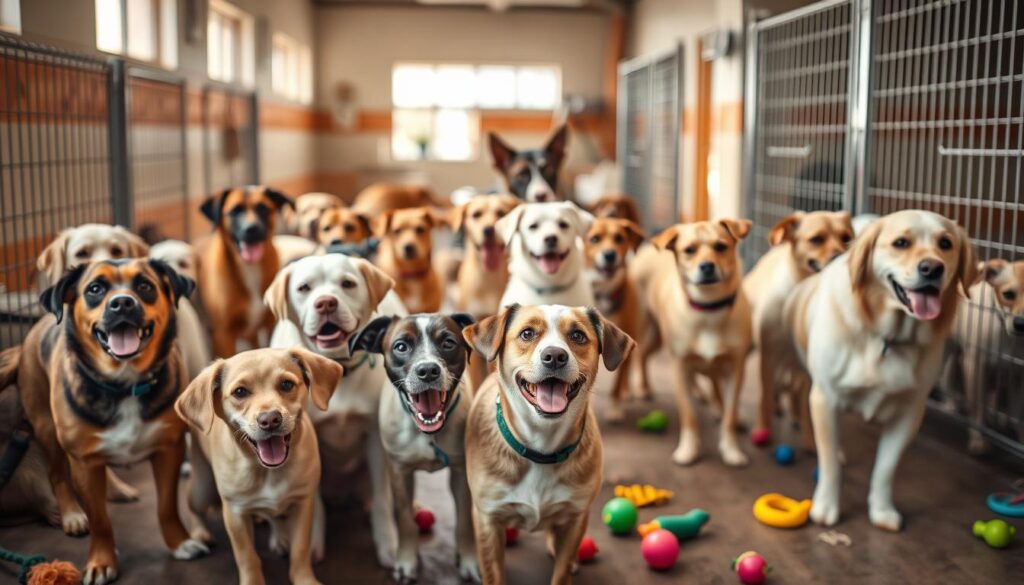
“Adopting a dog from a shelter is one of the most rewarding experiences you can have. These dogs are so grateful for a loving home, and they will shower you with affection and loyalty in return.”
But, adopting a shelter dog comes with challenges. They need time to adjust, may have behavioral issues, and need training and socialization. With patience and support from shelter staff, these amazing dogs can flourish in their new homes.
Things to Know Before Adopting a Dog
Adopting a dog is a rewarding experience but comes with big responsibilities. Before you decide, think about several important things. This includes your lifestyle, budget, and the needs of different dog breeds. We’ll cover the essential things to know before adopting a dog.
Assess Your Lifestyle and Household
First, check if your lifestyle fits a dog. Do you have enough time and energy for a dog? Also, think about other pets or kids in your home and how they’ll get along with a new dog.
Research Breeds and Their Needs
Different breeds have unique personalities and needs. Research breeds to find the best match for you. For example, small dogs live longer than large dogs. Knowing this helps you choose wisely.
Prepare Your Home for a New Dog
Make your home safe and comfy for your new dog. Pet-proof, set up feeding and sleeping spots, and keep water clean. Puppies and rescue dogs need extra patience and training.
Budget for Ongoing Expenses
Having a dog costs money for vet care, food, toys, and grooming. Think about these costs before adopting. Shelter dogs might have lower fees, but their long-term costs are important to consider.
Work with Shelter Staff and Behaviorists
When adopting from a shelter, work with staff and behaviorists. They know the dog’s personality and any issues. This helps you decide if the dog is right for you.
Adopting a dog is a big decision. By thinking about these factors, you can make a smooth transition. With the right preparation and commitment, having a dog can be incredibly rewarding.
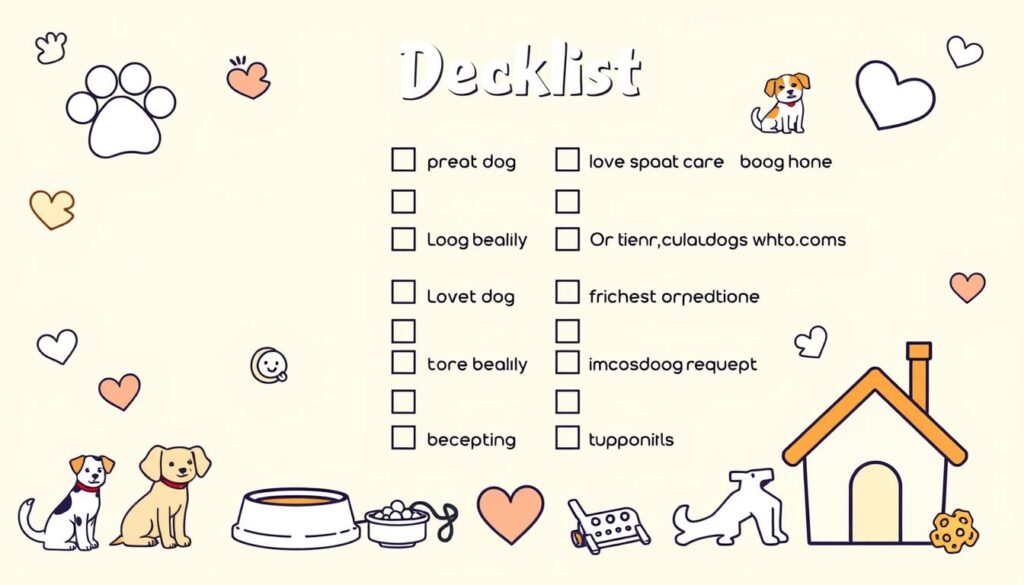
Assessing Your Lifestyle and Household for a Dog
Before getting a dog, think about if your home can handle it. Look at your daily life, how much time you have for a dog, and if you have other pets or kids. Some dogs love busy homes, while others prefer peace.
Considerations for Other Pets and Children
If you have a family with dogs or a multi-pet household, introducing a new dog needs careful planning. Start by slowly introducing the dog to your pets, watching how they react. Teach your dog to respect the space of your pets and kids.
- Make sure your dog-friendly home has enough room and resources for all pets.
- Watch how your new dog and kids interact, teaching them to be kind to each other.
- Choose a dog that matches your household’s energy and mood.
By thinking about your lifestyle and home, you can make sure your new dog is happy. This way, your whole family can enjoy a peaceful, dog-friendly home.
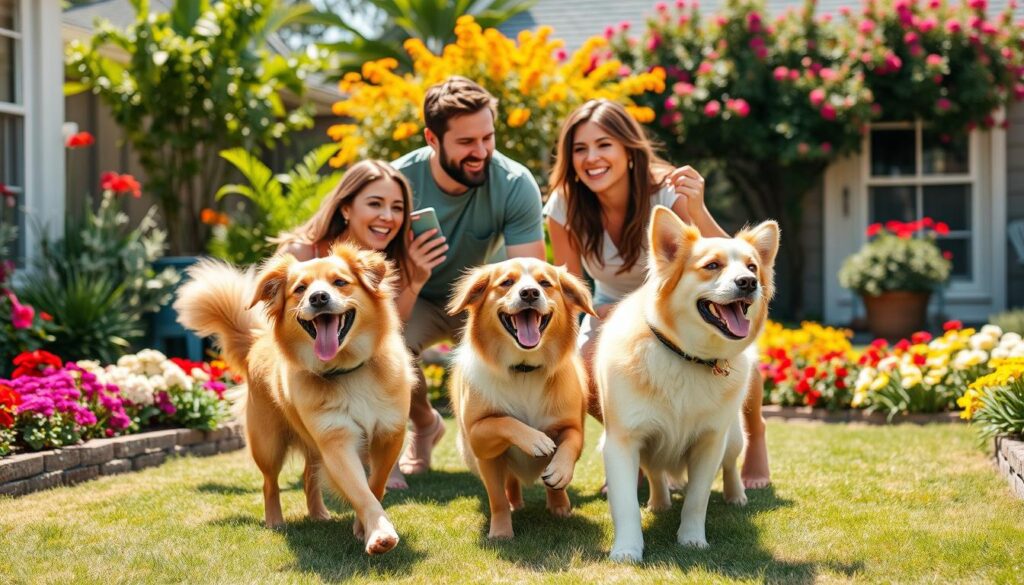
Understanding Dog Breeds and Their Needs
Adopting a dog means knowing what each breed needs. This includes size, energy level, and grooming. Each breed has its own special needs that can change your life.
Factors Like Size, Energy Level, and Grooming Requirements
Bigger dogs like German Shepherds and Great Danes need lots of space and exercise. They’re not perfect for small homes or quiet lives. Smaller dogs, like Beagles and Pugs, are better for homes with less room or for people who don’t move much.
Different breeds need different grooming. Dogs with thick coats, like Huskies and Samoyeds, need regular brushing. Short-haired dogs, like Greyhounds and Doberman Pinschers, need less grooming.
| Breed | Size | Energy Level | Grooming Needs |
|---|---|---|---|
| German Shepherd | Large | High | Moderate |
| Beagle | Medium | Moderate | Low |
| Poodle | Small to Standard | High | High |
| Greyhound | Large | Moderate | Low |
Learning about different dog breeds and their needs helps you choose the right one. This way, you can have a happy and lasting relationship with your new pet.

“Understanding the historical purpose and unique characteristics of a dog breed is crucial for ensuring a good fit between the dog and its new family.”
Preparing Your Home for a New Dog
Getting a new dog is exciting and rewarding. But, you need to make sure your home is safe and comfy for them. Before your dog arrives, pet-proof your home and set up a special area for them.
Pet-Proofing and Creating a Safe Environment
Start by securing electrical cords and hiding toxic plants. Make sure trash cans are out of reach. Create a cozy area with a bed, bowls, and toys. This space will help your dog feel at home.
Think about your other pets and family members too. Make sure all pets are healthy before introducing the new one. Slow introductions and supervision are key for a smooth transition.
Preparing your home well means a happy and easy start for your new dog. A safe and welcoming space will help your dog feel comfortable and confident.
| Tip | Description |
|---|---|
| Secure Hazards | Safely store away electrical cords, toxic plants, and easily accessible trash cans. |
| Establish a Dedicated Space | Set up a comfortable, well-equipped area for your dog, including a bed, water/food bowls, and engaging toys. |
| Consider Existing Pets | Ensure current pets are up-to-date on vaccinations and introduce the new dog gradually and with supervision. |
| Gradual Acclimation | Allow ample time for your new dog to adjust to their new home and household members. |
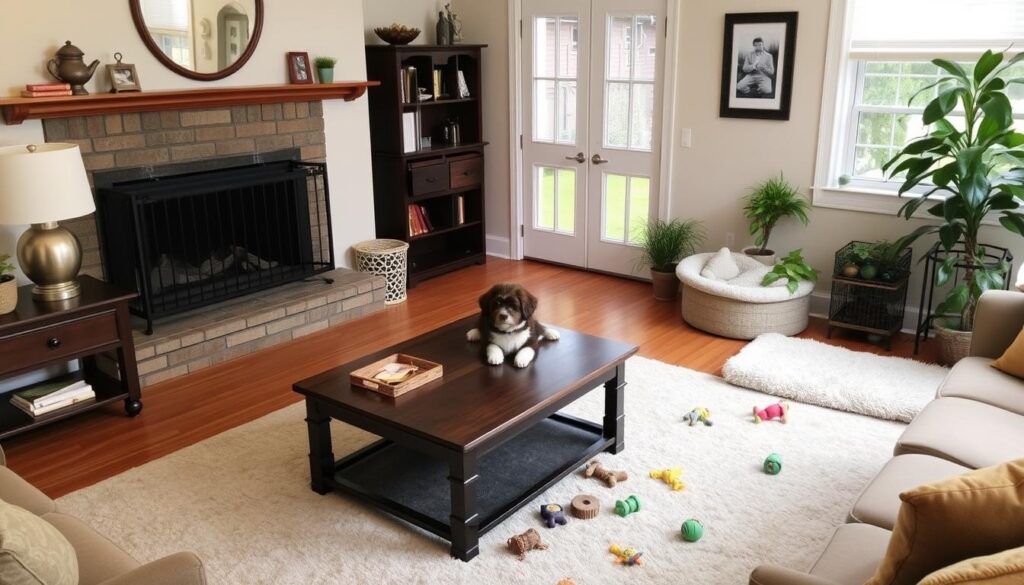
“Preparing your home for a new dog is crucial to ensuring their safety and comfort in their new environment. Taking the time to pet-proof and create a designated space can go a long way in facilitating a smooth transition for your canine companion.”
Budgeting for a Dog’s Expenses
Getting a dog is exciting, but it also means taking on new financial duties. You’ll need to budget for things like food, vet visits, toys, and more. The cost can vary a lot, depending on your dog’s size, age, and health.
A 2022 report by Rover.com found that adopting a dog can cost between $1,050 and $4,480. This is more than the usual $500 people think it will be. These costs cover things like adoption fees, shots, spaying or neutering, and basic supplies like a collar and crate.
After the initial costs, you’ll face yearly expenses of $480 to $3,470. You might also spend extra on things like food, vet visits, and grooming. These costs add up over time.
For breeds like Labradors and Golden Retrievers, the monthly cost is usually $50 to $150. This includes food, vet care, and basic supplies.
Getting a dog from a shelter can save you money. Adoption fees are $50 to $700, which is less than the $1,000 to $4,000 for a breeder-purchased dog.
Remember to include extra costs like ID tags, microchipping, and licenses in your budget. This way, you can avoid unexpected expenses and make sure your dog gets the care they need.
| Expense Category | Estimated Cost |
|---|---|
| Upfront Costs (Adoption, Supplies, etc.) | $1,050 – $4,480 |
| Recurring Annual Expenses (Food, Vet, Grooming) | $480 – $3,470 |
| Optional Annual Expenses (Training, Boarding, etc.) | $1,210 – $4,040 |
| Average Monthly Cost (Popular Breeds) | $50 – $150 |
| Adoption Fees (Rescue/Shelter) | $50 – $700 |
| Breeder-Purchased Dog | $1,000 – $4,000+ |
Knowing the costs of dog ownership and planning your budget can make for a happy, healthy relationship with your dog.
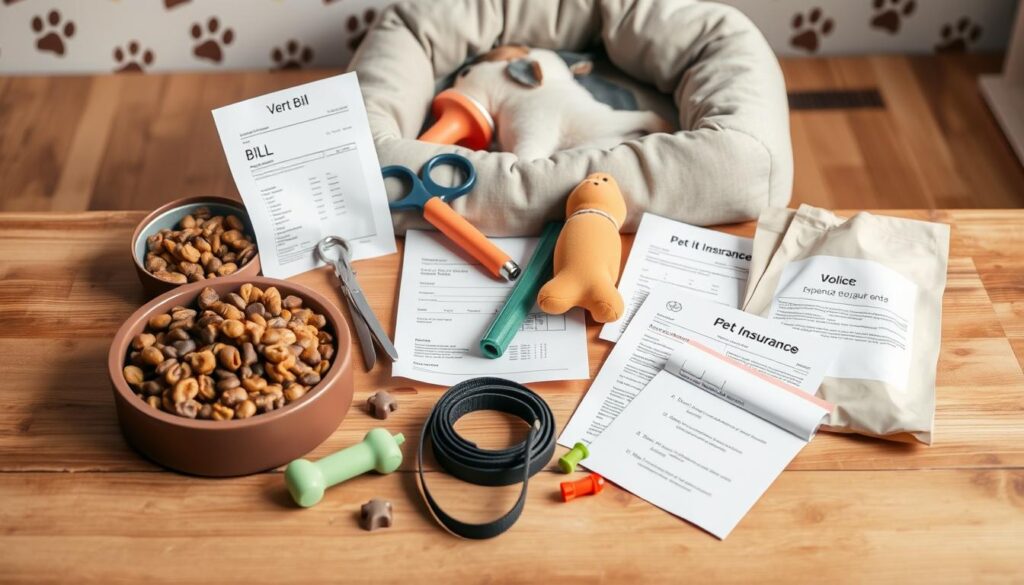
“Adopting a dog is one of the most rewarding experiences, but it’s important to be financially prepared for the responsibility. Budgeting for a dog’s expenses can help you provide the best care and ensure your furry companion’s needs are met.”
Choosing the Right Dog from a Shelter
Adopting a dog from a shelter means working closely with the staff. They know a lot about each dog’s personality and history. This helps you choose the right dog for your home.
Shelters do detailed behavior assessments. They look at a dog’s traits and challenges. This helps you pick a dog that fits your lifestyle.
Working with Shelter Staff and Behavior Assessments
Finding the right dog can seem hard, but shelter staff can help. They know how to read dog behavior. They can guide you to a dog that will do well in your home.
- Watch how the dog acts on walks and with people.
- Read the kennel card descriptions to learn about the dog’s personality.
- Know the difference between open-intake and limited-intake shelters.
- Visit when it’s not too busy to get more attention.
Choosing a shelter dog is a big decision. Take your time and trust your instincts. This way, you’ll find a dog that’s perfect for your family.
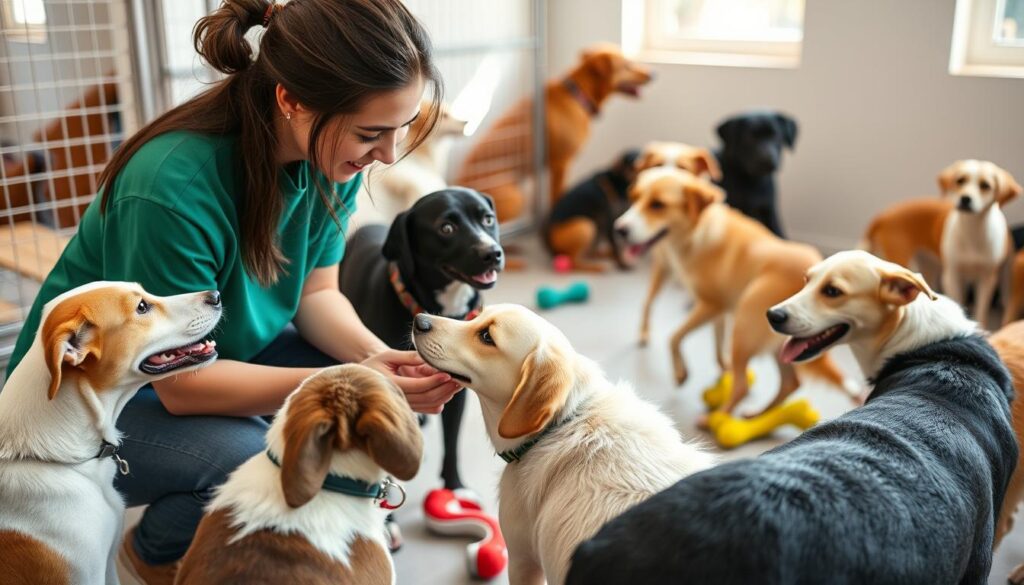
“The key to a successful shelter dog adoption is understanding the dog’s behavior and personality through careful observation and collaboration with the shelter staff.”
Bringing Your New Dog Home
Welcoming a new furry friend is exciting and rewarding. But, it needs careful preparation. When bringing home a new dog, having the right dog supplies is key. You also need to be ready for the dog acclimation period.
Supplies to Have Ready
Before your new dog arrives, make sure you have these essential items:
- Collar and leash
- Food and water bowls
- High-quality dog food
- Comfortable bedding
- Interactive toys and chews
- Cleaning supplies (e.g., enzymatic cleaner, poop bags)
The Acclimation Period
When your new dog first arrives, expect an acclimation period. This is when they adjust to their new home. It’s stressful for them, so keep things calm and let them explore at their own pace.
Experts say to limit the dog’s access to the whole house at first. Give them a “safe space” like a bedroom or crate. This makes them feel secure and prevents accidents or damage. As the first week goes by, you can let them explore more of the house while watching them closely.
Keeping a regular routine, like set feeding times and walks, helps them adjust. Also, give them mental stimulation with interactive toys. This can help reduce stress and prevent boredom.
With patience and gentle guidance, your new dog will soon feel at home. They will become a beloved part of your family.
Training and Socializing Your Rescue Dog
Adopting a rescue dog is rewarding but needs patience and commitment. Training and socializing are key for their happiness in your home.
Start by enrolling your dog in positive training classes. These classes teach basic commands and boost confidence. A gentle, reward-based approach is vital for their progress.
Also, give your dog lots of socialization chances. Arrange playdates or visit dog-friendly places. This helps them get used to new environments and people.
Remember, the “honeymoon period” for rescue dogs can last a few weeks to months. They may face behavioral challenges or seem overwhelmed. Stay patient, consistent, and positive to help them adjust.
Investing in your dog’s training and socialization strengthens your bond. It also ensures their long-term happiness and successful integration into your family. With the right approach, your rescue dog can thrive and bring joy to your life.
Overcoming Behavioral Challenges
Rescue dogs may face behavioral challenges due to their past. Work with a professional trainer or behaviorist to address these issues. Positive training and a consistent routine can help them overcome these challenges.
Establishing a Routine
Consistency and structure are vital for a rescue dog’s sense of security. Create a daily routine for feeding, walking, playtime, and training. This routine helps your dog feel safe and supports their learning.
Providing Exercise, Enrichment, and Mental Stimulation
It’s key to give your dog lots of dog exercise, dog enrichment, and dog mental stimulation. They need regular walks, playtime, and a safe outdoor area. But, it’s also important to keep their minds active to avoid boredom and promote good behavior.
Try using puzzle toys and training games to keep their minds sharp. Change these activities often to keep them interested. Scent games and foraging can also calm and reward your dog.
Playing indoor games with your dog can strengthen your bond. Games like fetch, tug-of-war, or hide-and-seek are great. Spending time on interactive play is good for both of you.
| Activity | Percentage of Dogs Engaged | Average Time Spent |
|---|---|---|
| Puzzle Toys | 82% | 30 minutes |
| Scent Games | 75% | 20 minutes |
| Interactive Play | 90% | 45 minutes |
Meeting your dog’s physical and mental needs makes them happy and well-adjusted. A happy, stimulated dog is a joy to have around.
Veterinary Care and Routine Health Checks
Getting a dog is a wonderful experience, but it also means taking care of their health. It’s important to find a good vet and keep up with health checks and care. This includes making sure they get all their shots, stay protected from fleas and ticks, and get any medical care they need.
Going to the vet regularly is key for your dog’s health. At these visits, the vet can check them over, find any problems early, and suggest ways to keep them healthy. By being proactive with your dog’s health, you can catch issues early and help them live a long, happy life.
It’s also good to know about common health issues in dogs, like skin problems, digestive issues, and joint problems. Learn about these and talk to your vet if you see any signs in your dog.
Investing in preventative dog veterinary care can save you a lot of trouble and money. By keeping up with your dog’s health, you can make sure they are happy and healthy for years to come.
“The greatest gift we can give our dogs is the gift of good health.”
Routine Health Checks and Preventative Care
- Annual wellness exams and vaccinations
- Flea, tick, and heartworm prevention
- Dental cleanings and care
- Spaying or neutering
- Monitoring for any health issues
By focusing on preventative care and building a strong vet relationship, you can make sure your dog is happy and healthy. They will be a beloved part of your family for years.
Conclusion
Adopting a dog can be very rewarding. But, it’s key to understand the responsibilities that come with it. Knowing your lifestyle, the needs of different breeds, and the costs and time needed is crucial. This way, you can give your new pet a loving home.
The cost of owning a dog can be high. From adoption fees of $100 to $400, to ongoing expenses for food, vet care, and supplies. Yet, the joy and companionship a dog brings can be worth it.
With patience, dedication, and the right support, you and your dog can have a great journey together. Whether you prefer a high-energy breed or a calm one, there’s a dog out there for you. They’re waiting at shelters or rescue organizations, ready to join your family.
FAQ
What are the key considerations before adopting a dog?
Before adopting a dog, think about your lifestyle and home. Learn about different breeds and their needs. Make sure your home is ready and budget for dog costs.
Also, prepare for the time it takes for your dog to adjust and for training.
How do I choose the right dog breed for my lifestyle?
When picking a dog breed, think about size, energy, and grooming needs. Consider if the breed fits your home and daily life. Do your research to find a breed that matches your lifestyle and care abilities.
What kind of supplies do I need to have ready before bringing a new dog home?
Get a collar, leash, bowls, bedding, toys, and grooming tools ready. Set up a special area for your dog before they arrive. This makes their transition smoother.
How important is training and socialization for a rescue dog?
Training and socialization are key for a rescue dog’s happiness and fit in your home. Sign them up for positive training classes. Give them lots of chances to meet new people and dogs.
What kind of veterinary care does a dog need?
Find a good vet and schedule regular check-ups and shots. Also, protect them from fleas and ticks. This keeps them healthy and happy.
What are the typical costs of owning a dog?
Having a dog means spending money on adoption fees and ongoing costs. This includes food, vet bills, toys, and more. The cost depends on the dog’s size, age, and health.

